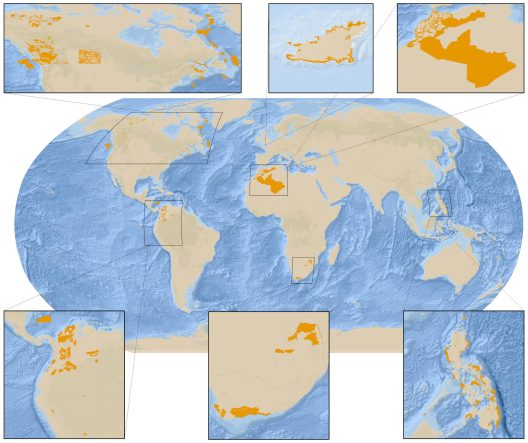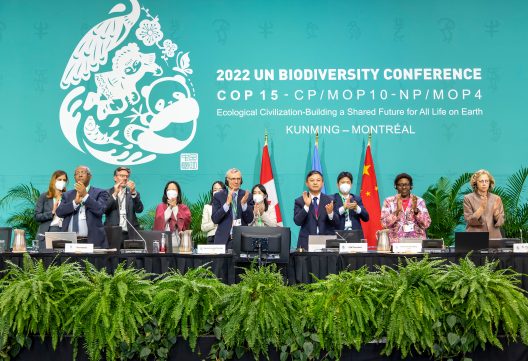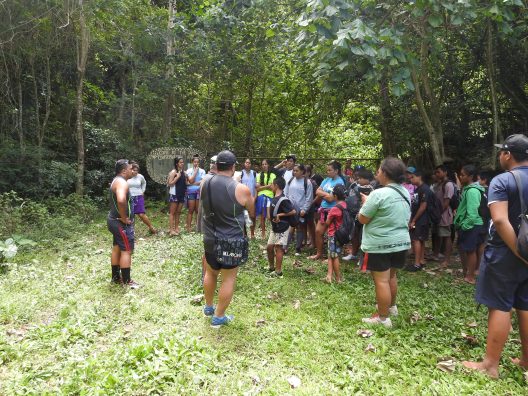Other Effective Area-Based Conservation Measures: A Path Towards Equitable Biodiversity Conservation
Expanding the Conservation Toolbox: The Role of OECMs Alongside Protected Areas
Many people are familiar with the idea of a protected area—land or water areas set aside and kept as natural as possible, such as national parks and nature reserves. Protected areas are one of the most well-established conservation tools, playing a crucial role in protecting biodiversity. However, they often require significant political will, funding, and enforcement and do not always account for lands and waters that are effectively conserved outside of formal protection.
Other effective area-based conservation measures (OECM) are conservation tools that are gaining recognition. First introduced in 2010 by the Conference of the Parties, the decision-making body of the UN Convention on Biological Diversity (CBD), the approaches were not formally defined and adopted until 2018. The CBD defines an OECM as:
“A geographically defined area other than a Protected Area, which is governed and managed in ways that achieve positive and sustained long-term outcomes for the in situ conservation of biodiversity with associated ecosystem functions and services and, where applicable, cultural, spiritual, socio-economic, and other locally relevant values.”
Unlike traditional protected areas, which are explicitly designated for conservation, OECMs recognize and support conservation occurring in places managed for other purposes. These can include community-managed lands, sacred natural sites, or working landscapes that sustain wildlife while also meeting cultural, economic, and spiritual needs. The concept has since been refined by the International Union for Conservation of Nature’s (IUCN) World Commission on Protected Areas working group to align with global conservation efforts. Additionally, the Food and Agriculture Organization (FAO) has developed an OECM Handbook to assist nations in implementing this approach within fisheries management.

OECMs have been incorporated into international conservation targets and strategic frameworks that guide biodiversity protection worldwide. These plans include ambitious goals like the “30×30” commitment, which aims to conserve 30% of the world’s land, freshwater, and ocean by 2030. While protected areas remain the primary tool for achieving these targets, OECMs offer a critical complementary approach. Recent research shows that adding OECMs has increased global terrestrial conservation coverage to 16.98%, up from 15.80% with just protected areas. While OECMs have only increased global marine coverage by 0.1%, at the national level, they have helped certain countries such as Canada, Columbia, and the Philippines make significant strides in marine conservation coverage.
As of April 2024, the World Database on Other Effective Area-based Conservation Measures has recorded 856 OECM sites across 10 countries and territories. Check out Protective Planet’s interactive map to learn more about these sites!
Unlike protected areas, which are created through designation for conservation purposes, OECMs are recognized for effectively achieving conservation alongside other primary objectives. That is, the primary goal of these areas is often not biodiversity conservation but rather the management of land or water for other purposes, such as cultural, spiritual, or economic activities—a concept known as “Ancillary Conservation.” OECMs can also include areas classified as “Primary Conservation,” which meet protected area standards but are not officially reported due to the governing authority’s decision—whether a national government, Indigenous peoples, or local communities—to withhold designation. Another category, “Secondary Conservation,” includes areas where biodiversity protection is a secondary management priority.
“…the primary goal of these areas is often not biodiversity conservation but rather the management of land or water for other purposes, such as cultural, spiritual, or economic activities—a concept known as “Ancillary Conservation.”
The governance of OECMs varies. Based on Decision 14/8 of the CBD, which provides the official framework for OECMs, the IUCN identifies four main governance types: government, private, Indigenous and community, and mixed. These diverse governance structures enable OECMs to adapt to local needs, further supporting their role as a complementary tool alongside protected areas in biodiversity conservation.
Another key way OECMs complement protected areas is through their contribution to connectivity, a cornerstone of effective biodiversity conservation. Because OECMs are managed for diverse purposes, they simultaneously can act as corridors linking fragmented habitats. By bridging the spatial gaps between protected areas, OECMs help build an interconnected network of conservation spaces that support ecosystem functionality across larger scales. This approach aligns with Indigenous and community-based conservation strategies, which often emphasize maintaining connectivity as part of sustainable land and water use practices.
OECMs as a Tool for Equitable Solutions to the Biodiversity Crisis
With a clear objective of benefiting both humans and biodiversity, OECMs have the potential to significantly contribute to a more equitable approach to biodiversity conservation. Their flexibility in governance and management creates opportunities to involve local communities and Indigenous peoples—often excluded from mainstream conservation—by recognizing diverse governance systems and integrating traditional ecological knowledge into broader conservation strategies. Additionally, the broader definition of an OECM allows for the idea that humans are a part of nature, a concept often incorporated into Indigenous values but not considered by the main governing bodies developing solutions for the biodiversity crisis.

OECMs have specific criteria that allow a wide range of managing authorities to identify and recognize areas for their contributions to biodiversity. This flexibility means that lands and waters managed for cultural, economic, or other purposes can also be acknowledged for their biodiversity conservation values. In many cases, recognizing an area as an OECM has the potential to empower local communities and Indigenous peoples by formally recognizing their long-standing stewardship of biodiversity. However, the extent to which this recognition translates to meaningful authority and decision-making power varies, and Indigenous perspectives must be centered on evaluating these outcomes.
Historical exclusions and mismanagement by government agencies and biodiversity conservation advocacy organizations have contributed to distrust among some land and water managers, which may make them hesitant to recognize their areas as protected areas. OECMs offer a way for Indigenous peoples to contribute to global biodiversity goals while maintaining governance over their ancestral lands. This process fosters collaboration between Indigenous peoples and external stakeholders, often resulting in conservation strategies that are more inclusive, respectful, and tailored to the needs of local communities. Furthermore, the establishment of OECMs can address some of the systemic challenges that hinder more equitable conservation, such as insecure land rights and insufficient funding.
“This process fosters collaboration between Indigenous peoples and external stakeholders, often resulting in conservation strategies that are more inclusive, respectful, and tailored to the needs of local communities.”
Addressing Key Challenges for OECM Success
While the recognition of Indigenous and community-led conservation within OECMs is promising, this remains largely aspirational. To fully realize the potential of OECMs as tools for equitable biodiversity conservation, experts have identified critical challenges. The Indigenous and Community Conserved Areas Consortium, an organization that advocates for the recognition and support of Indigenous and community-conserved areas, prepared a briefing on the Kunming-Montreal Global Biodiversity Framework that highlighted several key concerns with OECMs.

The ambiguity surrounding OECMs—particularly in their definition, governance structures, and recognition process—presents a risk if national authorities enact new legislation without meaningful consultation or “full and effective” participation of Indigenous peoples and local communities (ICCA, 2022). Furthermore, despite the self-identifying language in the guiding principle of Decision 14/8, concerns persist that the establishment of OECMs by governments under pressure to meet conservation targets could lead to rights violations and disregard of Indigenous self-determination or sovereignty As stated above, there are specific criteria to define an area as an OECM. While recognition of an OECM does not cost anything, meeting the required criteria and effectively managing an OECM can be time-consuming and costly for Indigenous peoples and local communities, often already overwhelmed by the ongoing effects of colonialism and climate change. This financial burden may lead governing bodies to rely on foreign aid or technical support, potentially undermining the idea of locally led conservation.
Alongside concerns about the potential misuse of OECMs, experts have also identified additional barriers that could hinder their success. A recent study gathers insights from marine conservation experts—scientists, policymakers, and practitioners—highlighting five key challenges that must be addressed to ensure OECMs fulfill their potential:
-
- The responsibility to prove an OECMs effectiveness should not fall on already under-resourced local and Indigenous communities.
- Sufficient resources must be mobilized to support the recognition and reporting of OECMs.
- There is a lack of understanding of OECMs compared to protected areas, which can create barriers to their implementation.
- OECMs should not be misused as a way to weaken existing marine conservation regulations.
- Strong social safeguards are necessary to protect the livelihoods, cultures, and traditions of new groups engaging with global conservation targets.
If these challenges go unaddressed, OECMs risk falling short of their promise, perpetuating inequities, and failing to deliver lasting biodiversity gains.
Pathways Forward: Strengthening OECMs for Global Biodiversity Goals
Achieving equitable biodiversity outcomes requires proactive steps to overcome the challenges OECMs face and ensure they fulfill their potential as a cornerstone of global conservation efforts. The same experts who uplifted pressing concerns around OECMs also recognize the opportunities for this area-based management approach to be successful. Key opportunities include recognizing and incorporating local and Indigenous management practices, strengthening customary tenure rights, fostering collaboration across conservation, fisheries, and local actors, and improving access to conservation resources. The ICCA Consortium’s briefing underscores these opportunities by providing recommendations for improving the current framework’s language. These adjustments can help OECMs contribute not only to biodiversity conservation but also to the well-being of communities, creating pathways for more inclusive and holistic solutions.
While strengthening the international framework is essential for refining OECMs, meaningful progress also depends on local implementation and empowerment. Supporting community-led governance, securing tenure rights, increasing funding access, and fostering regional knowledge-sharing networks can help ensure OECMs are not just a policy tool but a truly effective and equitable conservation approach. Combining policy improvements with meaningful local engagement will be key to ensuring OECMs reach their full potential.
OECMs can be a vital component in addressing the biodiversity crisis, offering a path towards prioritizing both ecological preservation and local management. Realizing their full potential will require continued commitment at every level—from local communities to international policymakers.
The following sources were used and are behind a paywall. Please reach out to the Currents Editor-in-Chief for access:
[1] Alves-Pinto, H., Geldmann, J., Jonas, H., Maioli, V., Balmford, A., Latawiec, A. E., Crouzeilles, R., & Strassburg, B. (2021). Opportunities and challenges of other effective area-based conservation measures (OECMs) for biodiversity conservation. Perspectives in Ecology and Conservation, 19(2), 115-120.
[2] Bani Maini, Blythe, J. L., Darling, E. S., & Gurney, G. G. (2023). Charting the value and limits of other effective conservation measures (OECMs) for marine conservation: A Delphi study. Marine Policy, 147, 105350
[3] Ban, N. C., Blythe, J., Briggs, J., Darling, E., Gurney, G. G., Palardy, J. E., Pike, E. P., Agostini, V. N., Ahmadia, G. N., Campbell, S. J., Epstein, G., Estradivari, Gill, D., Himes-Cornell, A., Jonas, H. D., Jupiter, S. D., Mangubhai, S., & Morgan, L. (2022). Avoiding the misuse of other effective area-based conservation measures in the wake of the blue economy. One Earth, 5(9), 969-974
[4] Cook, C. N. (2024). Diverse approaches to protecting biodiversity: The different conservation measures discussed as possible other effective area-based conservation measures. Conservation Letters, 17(4), e13027
[5] Blythe, J., Bennett, N., Evans, L., Brown, K., Turner, R. A., Baggio, J. A., Baker, D., Ban, N. C., Brun, V., Claudet, J., Darling, E., Di Franco, A., Epstein, G., Estradivari, Gray, N. J., Gurney, G. G., Horan, R. P., Jupiter, S. D., … Zafra-Calvo, N. (2023). Triple exposure: Reducing negative impacts of climate change, blue growth, and conservation on coastal communities. One Earth, 6(2), 118-130.
[6] Gurney, G. G., Darling, E. S., Ahmadia, G. N., Agostini, V. N., Ban, N. C., Blythe, J., Claudet, J., Epstein, G., Jonas, H. D., Armitage, D., Campbell, S. J., Cox, C., Friedman, W. R., Gill, D., Lestari, P., Mangubhai, S., McLeod, E., Muthiga, N. A., Naggea, J., … Jupiter, S. D. (2021). Biodiversity needs every tool in the box: Use OECMs. Nature, 595(7869), 646-649
[7] Jago, S. (2024). Reducing negative economic and equity implications associated with conserving 30% of the planet by 2030. Perspectives in Ecology and Conservation, 22(1), 8-11.
[8] Jonas, H. D., Bingham, H. C., Bennett, N. J., Woodley, S., Zlatanova, R., Howland, E., Belle, E., Upton, J., Gottlieb, B., Kamath, V., Lessmann, J., Delli, G., Dubois, G., Ahmadia, G., Claudet, J., Cook, C., Deza, J., Grorud-Colvert, K., Gurney, G., Lemieux, C. J., & Ruiz, L. (2024). Global status and emerging contribution of other effective area-based conservation measures (OECMs) towards the ‘30×30’ biodiversity Target 3. Frontiers in Conservation Science, 5, 1447434.